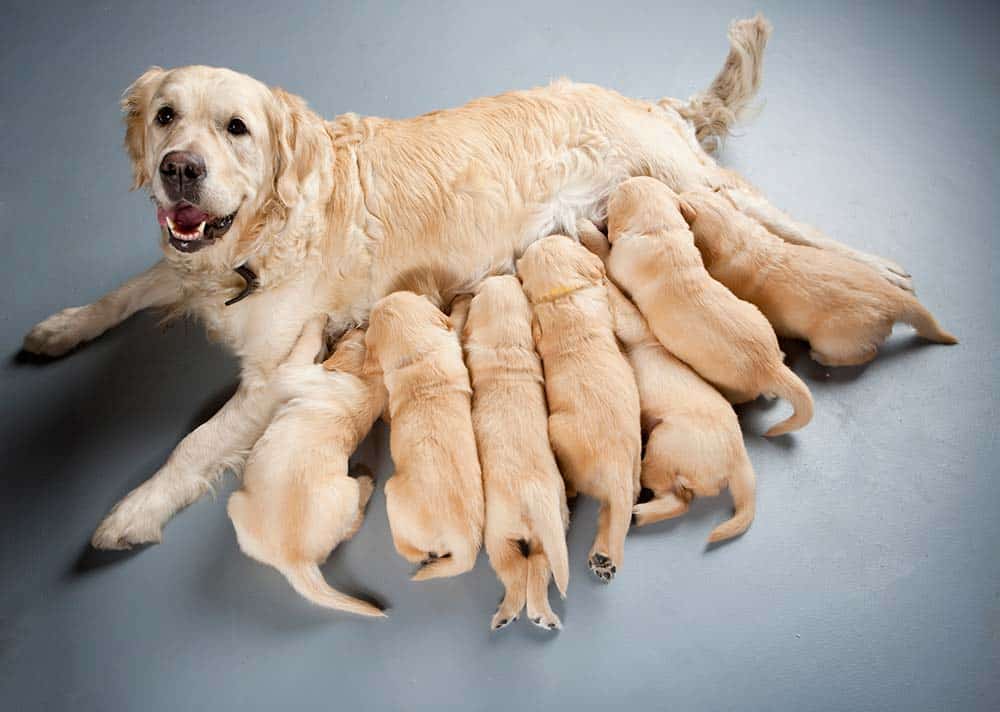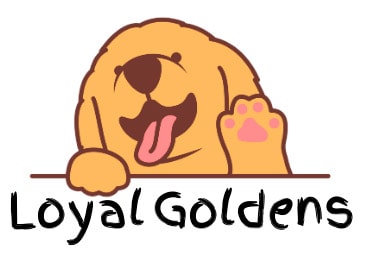If you have an unspayed female golden retriever, you’ll soon experience the trials and tribulations of a dog’s heat cycle. Most people think of a dog being “in heat” as the relatively short period of time just before she is actually fertile, but the entire heat cycle lasts much longer than this. So, what exactly is the heat cycle and how long does a golden retriever stay in heat?
A female golden retriever is “in heat” (fertile and open to advances) for 9 days on average during the Estrus stage of the heat cycle. A golden retriever’s complete heat cycle lasts 4 to 7 months and is divided into 4 stages: Proestrus, Estrus, Diestrus, and Anestrus.
This article will detail the 4 stages of the heat cycle and the signs of “being in heat”, as well as offering some advice on how to prepare for your dog’s heat.

(This article may contain affiliate links and loyalgoldens may earn a commission if a purchase is made.)
Unlock your goldens natural intelligence and see just how quickly problem behaviors disappear.This is the best at home dog training I've ever used!
Length of a Golden Retriever’s Heat Cycle
An unspayed female golden retriever will have her first heat cycle at 10 to 14 months of age, and will then have it repeat regularly. Since retrievers are fairly large dogs, their cycle is a bit slower, and they tend to have two heat cycles a year meaning on average a golden retriever’s complete heat cycle will last approximately 6 months.
While the heat cycle itself can last over a period of several months, a golden retriever is only technically “in heat” during a 4 – 24 day (9 days on average) stage of the heat cycle known as Estrus.
Note: Spayed female golden retrievers don’t have heat cycles, so if you see any heat symptoms in your spayed goldie, take her to the vet immediately. If you have several unspayed female dogs, their heat cycles will tend to sync up: one retriever in heat will bring the others into heat with her.
Recommended Reading: The Best Age To Spay or Neuter a Golden Retriever (Explained)
Stages of a Golden Retriever’s Heat Cycle
A dog’s heat cycle is divided into 4 stages: Proestrus, Estrus, Diestrus, and Anestrus. The length of this whole cycle is about 4 to 7 months. You can rack your golden retriever’s heat cycle as you would a period.
Proestrus (First Stage)
Proestrus is the stage where most people consider a dog to be in heat. It’s because this stage has the most visible signs of a dog entering into heat, but it’s not technically accurate because the dog isn’t fertile yet.
This first stage in the heat cycle can last anywhere from 4 to 27 days, with an average of 9 days. It’s signaled by a swollen vulva and bloody discharge. During this time, your retriever will release pheromones that will make her attractive to males. However, she will act more aggressively than usual to fend them off, as she is not yet fertile and is unwilling to mate.
Estrus (Second Stage)
Estrus is known as “standing heat” and lasts from 4 to 24 days (9 days on average). This is the stage a female golden is technically in heat. It’s the most sexually active part of the cycle and the point where your retriever is ovulating and fertile.
The most visible sign of a dog entering Estrus is that the discharge lessens and changes from red to pink. Your retriever may now welcome male advances, so unless your ready for puppies, keep her away from male dogs during this time.
You might see your retriever wagging her tail from side to side outdoors – this is called “flagging” and is a way of attracting male suitors and spreading her pheromones.
Diestrus (Third Stage)
Diestrus is the third stage of the heat cycle and lasts approximately 2 months. Your retriever is now no longer fertile, whether she’s pregnant or not, and may become aggressive towards males again. She is still emitting pheromones, however, so males will continue to be attracted to her. Discharge will go from pink back to red, and then will finally stop.
Anestrus (Fourth or Recovery Stage)
Anestrus is the final stage of the heat cycle and lasts about 4 months. This is the period of time when the dog can recover and prepare for the next cycle. There is no discharge and the vulva is no longer swollen. During Anestrus, your retriever’s body returns to its baseline, until the next cycle when Proestrus begins again.
Signs A Golden Retriever Is Going Into Heat
Swollen Vulva
During the beginning of the active heat cycle (Proestrus), the vulva may swell in size, becoming up to 3 or 4 times larger than normal. It will also stick out from the body. This is one of the first and most obvious signs of heat and precedes vaginal discharge.
Excessive Licking of Genitals
Along with the swelling of the vulva, your dog may begin licking her privates a lot. This may be to keep them clean from vaginal discharge, or because the swelling vulva may be itchy or uncomfortable.
Bleeding or Discharge
Your retriever will experience vaginal discharge and bleeding from the Proestrus to Diestrus stage. This discharge will change in color throughout the cycle, from red to pale pink, yellow, or brown, then back to red before it stops.
Many owners choose to put their dogs in special heat underwear for the duration of heavy bleeding. One product that works well for a golden retriever is the Wegreeco Washable Reusable Dog Diapers (Amazon), which come in many sizes and colors.
If your dog is bleeding outside of the appropriate stages of the heat cycle, you’ll want to visit the vet and get her tested for a urinary tract infection.
Frequent Urination
Along with bleeding, you may find your retriever urinating more often during estrus. Make sure to walk her often, or keep the door to the yard open.
Mounting
Your dog may start mounting other dogs, legs, or furniture when she becomes fertile and receptive to advances. Paired with the bleeding, this may be a danger to your furniture.
You might want to buy some protective furniture covers. Try the Purefit Reversible Quilted Sofa Cover (Amazon), which is easy to slide on and off your furniture. This cover’s also really helpful at other times to protect your sofa from being covered in dog fur.
Flagging
Mounting may also be accompanied by flagging. This is when your retriever will either hold her tail to one side to signal herself as open to advances or swish it from side to side to spread her pheromones. Like mounting, this only happens during Estrus.
Restlessness
During heat, your retriever will become much more alert and wary of male dogs. She may present herself as being skittish or nervous. You might want to keep your retriever inside more often during her heat to avoid needlessly stressing her out.
Changes in Personality
There are different behaviors associated with the different stages of the heat cycle. Proestrus and Diestrus are marked by heightened aggression, while Estrus may make your dog more outgoing and energetic. Your golden may become more clingy or protective of her family during her heat, or suddenly turn grumpy. You might want to give her a private area in the house where she can go when she’s in a bad mood.
How to Prepare for a Golden Retriever’s Heat Cycle
Here are some precautions you may want to take before your retriever’s heat:
- Track your dog’s cycle using a calendar app. This will let you know when another estrus is imminent, and you will have time to prepare suitably.
- Invest in some doggy diapers or protective covers for couch cushions and other surfaces in your house. This will prevent some of the messier accidents that may happen during her heat.
- Do not let your dog breed in her first heat: her eggs will still be immature, and you will have no warning about any health problems that might arise.
- Do not spay your dog during her heat. The vulva will swell excessively during or after the operation, and make recovery difficult.
- If you do not think that you could handle two dog heats a year and/or you don’t want your golden retriever to have puppies, then you might consider getting your dog spayed. Since heat is caused by the creation of estrogen in the reproductive system, having the reproductive system removed stops heats from happening. Getting your dog spayed can also help her live longer!
Golden Retrievers don’t experience menopause and unless they are spayed, continue to go through heat cycles for their entire lives. There is an age, however, when Golden Retrievers get too old to responsibly breed. Find out about it in our article here.
Final Thoughts
The golden retriever heat cycle happens every 4 to 7 months and should be tracked for ease of preparation. The cycle is divided into 4 stages, the second of which, Estrus, is the point where your golden retriever is fertile.
Signs of heat include a swollen vulva, bleeding, licking of genitals, and changes in mood.
There are ways to prepare for a retriever’s heat cycle: invest in some couch covers and washable dog diapers, and keep your dog away from males.
If you’re not feeling up to dealing with a dog in heat, then the best way to prevent this is to get your retriever spayed. This will adjust her mood and may help her live longer, as well as prevent unwanted pups.
More Golden Retriever Articles You’ll Love!
- How to Care for a Pregnant Golden Retriever (A Complete Guide)
- Can You Breed a Golden Retriever With a Miniature Poodle? (Explained!)
- Can Golden Retriever Puppies Swim? (And Is It Safe?)
- The World of Golden Retriever Coat Colors (with Pictures!)
